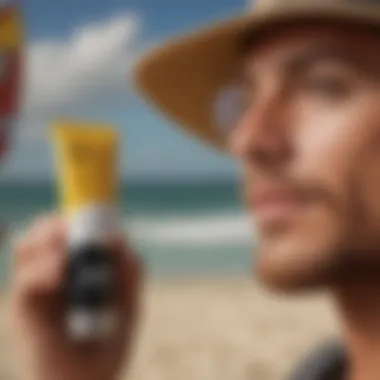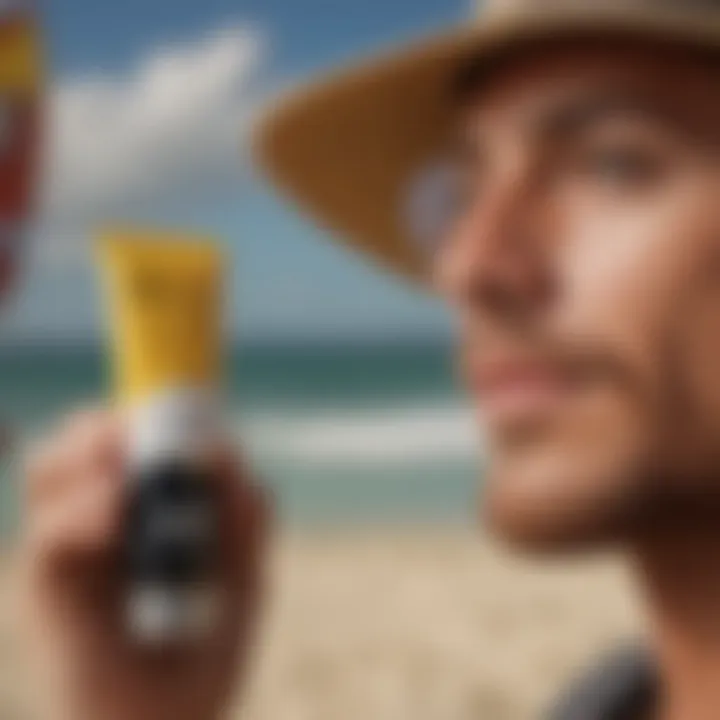Optimal Sun Protection: Best Sunblock for Surfers


Intro
Sun protection is a critical consideration for anyone spending long hours outdoors, particularly for surfers. The delicate balance of enjoying the waves while shielding skin from harmful UV rays is a concern for both amateurs and seasoned surfers alike. This article delves into the nuanced world of sunblock, narrowing the focus on options that cater specifically to the unique demands of surfing. In the pursuit of optimal sun protection, surfers must consider various factors such as UV protection levels, water resistance, skin compatibility, and the specific application techniques that enhance effectiveness.
Understanding these aspects empowers surfers to make informed decisions about their skin health, ensuring that they can relish their time on the ocean without compromising their long-term wellbeing. As we explore the best sunblock options for surfers, our goal is to equip you with the insight necessary for making the right choice, enabling safe and enjoyable surfing experiences.
Understanding the Importance of Sun Protection for Surfers
Surfers spend a significant amount of time outdoors, often under intense sunlight. It is vital to understand why sun protection is not just an option but a necessity for anyone engaging in this sport. The sun emits ultraviolet (UV) radiation, which can lead to skin damage, and surfers frequently find themselves on the front lines of this exposure. The ocean's reflective surface can intensify this effect, making proper sun protection even more critical.
Sun protection solutions provide a barrier against UV rays, minimizing the risk of severe skin issues. This is not only about preventing sunburn; it is about maintaining skin health over time. Repeated and unprotected exposure to the sun can lead to various skin conditions, some of which are life-threatening.
In addition to the personal health benefits, awareness of sun protection plays a role in the broader surfing community. Surfers can lead by example, encouraging each other to prioritize skin care. Doing so helps to promote a culture of safety and responsibility.
Effects of UV Radiation
The primary concern with UV radiation is its two types: UVA and UVB. UVA rays penetrate the skin deeper and can contribute to skin aging and the risk of skin cancers. In contrast, UVB rays cause sunburns and are known to play a significant role in developing skin cancer. Both types can cause immediate and long-term damage. Therefore, it is essential to use sunblock that provides broad-spectrum protection.
Skin Damage and Its Consequences
Skin damage from UV radiation can take many forms. Short-term effects, like sunburn, are painful and can hinder surfing activities. Long-term consequences include premature aging, characterized by wrinkles and loss of skin elasticity. More concerning is the risk of skin cancers, including melanoma, which can be fatal. The consequences of neglecting sun protection can be severe, making timely intervention critical.
Accumulative Nature of Sun Exposure
Many surfers do not realize that the effects of sun exposure accumulate over time. Each session in the sun may seem harmless, but small doses add up. This cumulative exposure increases the risk of developing skin issues later in life. Some studies suggest that even brief exposure can have lasting effects. Thus, applying sunblock before hitting the waves is not just a good practice; it is an essential part of a surfer's routine.
In essence, understanding the importance of sun protection sets the stage for healthier and safer surfing experiences. Prioritizing this aspect leads to better skin health, enhanced performance, and a more sustainable approach to the sport.
Criteria for Choosing Sunblock for Surfers
Selecting the right sunblock is crucial for surfers, who often face prolonged sun exposure while engaging in their sport. This section highlights specific criteria vital for making an informed decision. Key elements such as broad-spectrum protection, water resistance, and skin type compatibility play essential roles in ensuring skin safety and overall enjoyment during outdoor activities. Understanding these factors will help surfers optimize their sun protection regimen.
Broad-Spectrum Protection
Broad-spectrum protection is essential in sunblock, as it indicates the product’s ability to shield against both UVA and UVB rays. UVA rays penetrate the skin deeply and contribute to premature aging and skin cancer. On the other hand, UVB rays are responsible for sunburn and can directly damage skin cells. For surfers, a sunblock with broad-spectrum protection is non-negotiable, as they are exposed to high levels of sunlight reflected from the water surface.
Look for sunblock that specifically states "broad-spectrum" on the label, sporting an SPF of at least 30. This level provides adequate protection for most skin types, but individuals with fair skin may benefit from higher SPFs. Moreover, products with physical blockers, like zinc oxide or titanium dioxide, often offer effective coverage against both types of UV rays.
Water Resistance Ratings
Water resistance is another critical criterion when choosing sunblock for surfing activities. Surfers will often be in the water, making it essential that their chosen sunscreen maintains its effectiveness even after exposure to water and sweat. Sunblock usually comes with water resistance ratings, which are classified into two categories: 40 minutes and 80 minutes.
Selecting an 80-minute water-resistant sunblock means you can enjoy longer sessions in the water without frequent reapplications. However, it is important to note that no sunblock is entirely waterproof, so frequent reapplication after exiting the water or towel drying is still necessary.
Skin Type Compatibility
Not all sunblocks work the same for every skin type, making skin type compatibility a fundamental consideration. Surfers may have different skin conditions; some may have oily skin, while others may experience dryness or sensitivity. It is crucial for surfers to choose a product that aligns with their specific skin needs to avoid potential irritation or breakouts.
For oily skin, gel-based sunblocks are often more suitable, as they provide a lightweight feel without clogging pores. For dry or sensitive skin, creamy formulations that include moisturizing ingredients can help in preventing skin further dryness. Individuals with sensitive skin should look for fragrance-free, hypoallergenic products to minimize irritation risk.
In summary, surfers need to consider broad-spectrum protection, water resistance ratings, and skin type compatibility when selecting sunblock. These criteria ensure both adequate sun protection and comfort during aquatic activities.
Ingredients to Look For in Sunblock
When surfing, proper sun protection goes beyond just slathering on any product from the store. Understanding the ingredients in sunblock is essential for ensuring the skin’s safety and effective protection against harmful UV rays. Surfers spend prolonged periods in the sun, making careful selection of sunblock ingredients a priority. Factors to consider include their effectiveness, skin compatibility, and potential environmental impact. This section discusses essential ingredients while highlighting their importance, effectiveness, and considerations.
Physical vs. Chemical Sunscreens
Sunblocks primarily fall into two categories: physical and chemical.
- Physical sunscreens, often containing zinc oxide or titanium dioxide, act as a barrier on the skin's surface. They reflect UV rays, thus preventing them from penetrating the skin. This type of sunblock starts working immediately upon application, making it suitable for surfers ready to hit the waves without delay.
- Chemical sunscreens, on the other hand, absorb UV radiation through their chemical compounds. Ingredients like avobenzone, octisalate, octocrylene, and oxybenzone form this category. Although they offer broad-spectrum protection, chemical formulations may take about 20 minutes to become effective. Surfers should be cautious as some chemical ingredients can irritate sensitive skin, necessitating further scrutiny of individual skin reactions.


Important: For surfers, the choice between physical and chemical sunscreens may boil down to personal preference and skin type. Those with sensitive skin often prefer physical options.
Active Ingredients Explained
The effectiveness of a sunblock largely hinges upon its active ingredients. Key components to examine include:
- Zinc Oxide: Known for its broad-spectrum protection, this mineral is less likely to irritate sensitive skin.
- Titanium Dioxide: Another mineral that provides excellent UV protection by reflecting sunlight.
- Avobenzone: A common chemical filter that protects against UVA rays but degrades quickly when exposed to sunlight. Many formulations pair it with stabilizing agents.
- Oxybenzone: A widely used chemical sunscreen ingredient that can absorb UV rays but has been associated with coral reef damage, raising environmental concerns.
Surfers should prioritize formulations that contain these beneficial ingredients to ensure adequate UV protection while being mindful of their skin's response to specific components.
Avoiding Harmful Chemicals
Many sunscreens on the market may contain harmful ingredients which should be avoided:
- Oxybenzone: Apart from potential skin irritations, its adverse effects on marine ecosystems highlight its importance in reef-safe formulations.
- Parabens: These preservatives can disrupt hormonal function and may have long-term health effects.
- Fragrance: Often contributes to skin irritations and allergies, especially for individuals with sensitive skin.
Selecting sunblocks free from these harmful chemicals can benefit individual health and protect marine life. It is best for surfers to opt for products labeled as reef-safe, which typically avoid potentially damaging ingredients to ocean ecosystems.
In summary, understanding these aspects of ingredients in sunblocks adds a layer of conscientiousness to sun protection practices. Surfers can make informed decisions that safeguard their skin and marine environments.
Top Sunblock Brands for Surfers
In selecting the most appropriate sunblock, surfers face unique challenges. The ocean environment presents specific demands, such as prolonged exposure to UV rays and the necessity for water resistance. Thus, top sunblock brands for surfers not only provide adequate sun protection but also cater to the practical needs of aquatic activities. Quality brands not only safeguard against harmful rays but also ensure that surfers can enjoy their time in the water without constantly worrying about reapplication or skin irritations.
Reef-Safe Options
Many surfers are now aware of the environmental impact of traditional sunblock on our oceans. Chemical ingredients can drastically harm coral reefs and marine life. Reef-safe sunblocks prioritize natural components that are less likely to cause ecological damage. These products typically use mineral-based sunscreens containing zinc oxide or titanium dioxide. Such ingredients protect skin while minimizing environmental harm. Brands like Badger, SunBum, and Raw Elements produce sunblocks that are labeled as reef-safe. Selecting these options not only ensures personal protection but also contributes to ocean conservation efforts.
Dermatologist Recommended Products
Choosing a sunblock also involves understanding which products skin professionals endorse. Dermatologist recommended sunblocks often feature tested formulations ideal for various skin types and sensitivity levels. These products tend to prioritze broad-spectrum protection, are less likely to cause irritations, and are often free from harsh additives. Notable brands in this category include Neutrogena, La Roche-Posay, and CeraVe. These products provide reliable protection while being suitable for sensitive skin, especially for surfers who may face harsh conditions.
Budget-Friendly Choices
Affordability should not compromise sun protection quality. Many brands offer effective sunblock options that cater to budget-conscious surfers. Products from brands such as Coppertone, Banana Boat, and Equate deliver decent protection at lower price points. These sunblocks may have fewer specialized features, but they still provide adequate UV defense suitable for recreational and casual surfers. By evaluating price versus performance, surfers can find suitable sunblock options without strain on their finances.
Application Techniques for Maximum Effectiveness
The efficacy of sunblock is significantly linked to how it is applied, especially for surfers who spend extended time in the water. Understanding proper application techniques ensures surfers receive the full benefits of the product they choose. Sunblock not only protects the skin from harmful UV rays but also must adhere well to maintain its shielding properties throughout surf sessions.
Proper Application Methods
Applying sunblock effectively involves a few straightforward steps. First, it is crucial to cover all exposed skin areas. Surfers should pay close attention to often-neglected spots such as the ears, back of the neck, and tops of the feet. A common mistake is to apply sunblock too sparingly. Instead, a generous amount is advisable. It is recommended to use at least one ounce, or a full shot glass, of sunblock for the entire body.
The application should ideally happen at least twenty minutes before surfing. This allows the active ingredients to bind properly to the skin. For those using sprays, it is essential to rub the spray into the skin to ensure even coverage. Creams tend to provide a more consistent layer and may be preferable for those surfing in particularly hot or direct sunlight.
Reapplication Guidelines
Reapplication is as important as the initial application. Water and sweat can diminish the effectiveness of sunblock. The general rule is to reapply every two hours, regardless of whether one has been in the water or not. After swimming or excessive sweating, it is critical to reapply immediately, as most sunblocks lose their effectiveness after water contact, even those labeled as waterproof. Many manufacturers recommend checking individual product instructions, as formulations vary.
Timing Your Application
The timing of sunblock application plays a pivotal role in its effectiveness. Ideally, surfers should apply sunblock about twenty minutes before heading out. This time allows the skin to absorb the product. For those who surf during peak sun hours, typically between 10 a.m. and 4 p.m., this rule becomes even more essential. Waiting until the last moment might lead to gaps in protection, especially if a person enters the water soon after applying.
Sun Protection Beyond Sunblock
Sunblock is crucial for protecting surfers from harmful UV rays, but it is only part of a broader sun protection strategy. Simply applying sunblock is not sufficient to ensure comprehensive skin protection. Other elements are equally important, and each contributes to an overall approach that minimizes skin damage and enhances safety during surf activities.
Incorporating protective clothing and accessories, utilizing sunglasses, and seeking shade are essential practices to complement the application of sunblock. Each of these strategies not only assists in reducing direct exposure to sunlight but also supports the effectiveness of the sunblock applied. Moreover, they play vital roles in overall comfort and health while enjoying surfing.
Protective Clothing and Accessories
Wearing appropriate clothing is one of the most effective ways to protect the skin from sun exposure. Rash guards, wetsuits, and UV-protective swimwear are excellent options for surfers. These garments do more than just shield the skin; they also help regulate body temperature, which is beneficial when spending extended periods in the water.


Some key points about protective clothing include:
- Material Matters: Look for fabrics labeled with UPF (Ultraviolet Protection Factor), which indicate the level of sun protection provided. A higher UPF number corresponds to better protection.
- Coverage: Longer sleeves and longer shorts or swim trunks provide more coverage compared to regular swimsuits. Coverage helps prevent sunburn and reduces the amount of skin exposed to harmful rays.
- Accessories: Items like wide-brimmed hats can further shield the face and neck, and sun gloves can protect the hands from both sun and abrasion.
Sunglasses and Their Importance
Sunglasses are often overlooked in sun protection discussions, yet they are crucial for safeguarding the eyes from UV radiation. Prolonged sun exposure can lead to cataracts and macular degeneration. Therefore, investing in quality sunglasses is an important consideration for surfers.
Key factors in choosing sunglasses include:
- 100% UV Protection: Ensure the sunglasses specifically state that they block out 100% of UVA and UVB rays.
- Polarized Lenses: These lenses reduce glare from the water surface, providing better visibility and enhancing the overall surfing experience.
- Wraparound Styles: Sunglasses that wrap around the sides of the face provide additional protection by minimizing UV exposure from angles that standard glasses do not cover.
Staying in the Shade
While surfing often involves limited time in shaded areas, knowing when and how to take breaks in the shade can significantly reuce overall sun exposure.
Important considerations regarding shade include:
- Timing: The sun's rays are most intense between 10 a.m. and 4 p.m. If it is possible, plan surf sessions for early morning or late afternoon when the sun is less intense.
- Natural Shade: Look for trees, umbrellas, or shade structures on beaches. Even briefly resting in the shade can give the skin a break from constant UV exposure.
- Portable Shade Solutions: For longer beach days, using portable sun shelters can allow surfers to create their own shaded areas where they can rest and recuperate between surf sessions.
"Proactive measures like clothing, accessories, sunglasses, and shade not only reduce the risk of skin damage but also enhance the surfing experience."
In summary, while sunblock is a critical tool for sun protection, expanding the strategy to include protective clothing, reliable sunglasses, and consistent shade can create a more comprehensive and effective approach to safeguard skin and overall health during surfing activities.
Environmental Considerations
Environmental sustainability is a crucial concept that surfers must consider when choosing sunblock. The ocean is not only a playground for surf enthusiasts but also an ecosystem that supports a diverse range of marine life. Understanding how sunscreen impacts these ecosystems can inform better choices, promoting both skin health and environmental well-being.
Impact of Sunblock on Marine Ecosystems
Many sunblocks contain ingredients that are harmful to marine life. The most discussed components are oxybenzone and octinoxate, which have been linked to coral bleaching. When surfers apply these products, they wash off in the water, leading to detrimental effects on coral reefs and other marine organisms.
Research shows that as little as a drop of sunscreen can contaminate up to six Olympic-sized swimming pools worth of water. This contamination can cause hormonal disruptions in fish and other sea creatures, affecting their reproduction and survival. By recognizing these impacts, surfers can make informed decisions.
Choosing Eco-Friendly Products
Surfers should seek out sunblocks labeled "reef-safe" or "ocean-friendly." These products typically use zinc oxide or titanium dioxide as active ingredients. Both of these compounds are less harmful to marine ecosystems than their chemical counterparts. When looking for eco-friendly sunblock, consider the following factors:
- Ingredient Transparency: Look for brands that clearly list their ingredients and avoid harmful chemicals.
- Bio-degradable Packaging: Choose products that come in packaging that can decompose or be recycled.
- Natural Ingredients: Prefer formulas made entirely from plant-based sources.
Always remember, what you apply on your skin can affect the waters you surf in. Choose wisely.
The Role of Skin Care in Sun Protection
Skin care plays a fundamental role when it comes to effective sun protection for surfers. The harsh environmental conditions, along with prolonged sun exposure, can significantly damage the skin. Understanding how to properly care for the skin before and after surfing is vital. Not only does it help in preventing sunburn but also minimizes long-term skin damage such as premature aging and skin cancer.
Key Benefits of Skin Care in Sun Protection:
- Prevention of Sunburn: Good skin care routine supports the application of sunblock and helps maintain skin integrity.
- Skin Repair Mechanism: After surfing, skin restoration is key to healing and hydration.
- Minimizing Skin Conditions: Surfing can exacerbate certain skin issues; therefore, tailored care is essential.
Surfers need to be aware that a solid skin care regimen complements sunblock effectiveness and can enhance overall skin health.
Common Misconceptions about Sunblock
Understanding the common misconceptions about sunblock is crucial for surfers. Misleading information can lead to inadequate protection against harmful UV rays. Many surfers may not realize that sunblock is necessary not just for long days at the beach, but also for short sessions that expose skin to direct sunlight. Ensuring accurate knowledge can empower surfers to make better choices for their skin health.
Higher SPF Equals Better Protection
A prevalent myth is that a higher Sun Protection Factor (SPF) always translates to better protection. This is misleading. While it is true that higher SPF values provide increased protection against UVB rays, the difference isn't as significant as many believe. For instance, SPF 30 blocks about 97% of UVB rays, whereas SPF 50 blocks around 98%. The marginal gain does not necessarily justify the assumption that one is significantly safer with a higher SPF.
In addition, many individuals misinterpret the duration of protection. A common mistake is thinking that an SPF 50 sunscreen allows one to spend twice as long in the sun as an SPF 25 without reapplying. This assumption neglects factors like skin type, sun intensity, and application thickness, which greatly influence a sunscreen's effectiveness. Therefore, regardless of SPF, reapplication every two hours or after swimming is essential.


Only Sunny Days Require Sunblock
Another misunderstanding is the belief that sunblock is only necessary on sunny days. This idea can be dangerous for surfers. UV rays can penetrate clouds and still cause skin damage even on overcast days. Up to 80% of the sun’s UV rays can reach the skin while surfing in the shade of clouds.
Surfers may also be exposed to UV radiation reflected from surfaces like water, sand, or snow. This means that conditions like fog or haze can still result in significant sun exposure. It is advisable to wear sunblock consistently regardless of the weather conditions for effective protection against UV radiation. Using sunblock as part of a regular routine can help maintain skin health and reduce the risk of long-term damage.
Regularly applying sunblock, even on non-sunny days, is essential for maintaining skin health.
To conclude, addressing these misconceptions is vital for surfers looking to protect their skin. Higher SPF does not equate to a safer experience, and sun protection is necessary regardless of weather conditions. By understanding these misconceptions, surfers can implement better sun safety practices.
Review of Popular Sunblock Products
Reviewing popular sunblock products holds significant relevance for surfers. The unique conditions faced by surfers, including extended sun exposure and water immersion, require careful consideration of product performance. Through a detailed review of various sunblock options, surfers can make informed decisions that ensure their skin is adequately protected while enjoying their sport.
In this section, we will explore specific brands that have garnered attention in the surfing community. Factors such as efficacy, application ease, and waterproof capabilities play a crucial role in evaluating these products. Surfers need to find blends that do not just promise protection but deliver it consistently under real-world conditions.
In-Depth Analysis of Selected Brands
The analysis begins with several leading brands known for their commitment to high-quality sun protection.
- Neutrogena Beach Defense - This product is recognized for its robust formulation designed for water sports. The water-resistant claims hold for up to 80 minutes, making it a favorite among surfers. Its lightweight texture allows for easy application, leaving no greasy residue.
- Zinc Zipper - Targeted towards the environmentally-conscious, this reef-safe brand employs non-nano zinc oxide as its active ingredient. The formulation is not only effective in blocking UV rays but also free from harmful chemicals that can damage marine life.
- Coppertone Sport - Known for its extensive line of sports lotions, Coppertone Sport provides reliable coverage in intense conditions. The product provides sweat and water resistance, and it is widely accessible at various retail locations.
The comparison of these brands highlights the vital differences in formulation, effectiveness, and ecological suitability.
User Feedback and Reviews
Understanding user feedback is essential. Surfers often share their experiences on platforms such as Reddit and Facebook, discussing the strengths and weaknesses of different products.
Recent reviews reveal key insights:
- Many users praise Neutrogena Beach Defense for its high level of protection and ease of application. However, some have pointed out initial white residue that can be easily rubbed in.
- Zinc Zipper receives commendations for its eco-friendly formula, although a few users mention that its thick texture can be challenging to spread evenly on the skin.
- Feedback on Coppertone Sport frequently highlights its effectiveness during long surf sessions, although some users express concerns about the product's compatibility with sensitive skin.
Ultimately, consumer experiences provide valuable perspectives, allowing surfers to weigh their options based on real-life usage.
"Finding the right sunblock can mean the difference between a good day surfing and suffering from painful burns. It’s about both protection and performance."
By reviewing popular sunblock products through an analytical lens, surfers are better equipped to protect themselves while enjoying the ocean.
Epilogue
In wrapping up the vital discourse on sunblock for surfers, it becomes evident that comprehensive protection from UV radiation is not merely an option, but a necessity. This article has traversed multiple facets of sun protection, effectively highlighting the unique challenges faced by surfers due to prolonged sun exposure.
Summarizing Key Points
To encapsulate the key aspects discussed:
- Understanding UV Effects: Surfers are often exposed to damaging UVA and UVB rays, which can lead to various skin problems, including burns, premature aging, and even skin cancer.
- Selecting the Right Sunblock: Not all sunblocks are created equal. Surfers should prioritize products that offer broad-spectrum protection while being water-resistant and suitable for their specific skin type.
- Active Ingredients Matter: The distinction between physical and chemical sunscreens is crucial, as each has unique effects on the skin and the environment.
- Importance of Application: Correct application techniques and timely reapplication can significantly enhance the effectiveness of sunblock, providing sustained protection.
- Environmental Concerns: An awareness of the environmental impact of certain sunblock ingredients can also help surfers make informed choices that protect not only their skin but marine ecosystems as a whole.
Final Recommendations
As a closing thought, selecting a sunblock should be a deliberate process for anyone engaged in surfing, from novices to seasoned veterans. Surfers must seek out products explicitly formulated for their rigorous conditions.
- Invest in Quality: Consider investing in brands like Banana Boat, SPF Sport, or Neutrogena, which often innovate with formulas designed specifically for active lifestyles.
- Adopt Holistic Sun Protection: Beyond just using sunblock, integrating protective clothing and seeking shade will further enhance skin protection.
- Continue Learning: Stay updated about recent discoveries related to sun safety and the impacts of UV exposure.
Surfers can ensure their skin remains healthy and protected while enjoying their passion for riding the waves. The choices made today will reflect in their skin’s condition tomorrow, making informed decisions essential.
Citing Relevant Studies
Citing studies is crucial in substantiating the claims made regarding sunblock efficacy and its essential role in skin protection. Various studies show that surfers are exposed to extended UV radiation, which can dramatically increase their risk for skin cancer. For example, a study published in the Journal of the American Academy of Dermatology highlights that sunscreen use significantly reduces the incidence of sunburns among individuals who spend prolonged periods outdoors. Notably, research underscores the differences in effectiveness between chemical and physical sunscreens, indicating that surfers should consider these findings when choosing their products.
Additionally, studies conducted by the Skin Cancer Foundation demonstrate that using broad-spectrum sunscreens effectively shields the skin from both UVA and UVB rays. By referencing these credible sources, surfers can better comprehend the science behind sun protection and appreciate the urgency of integrating such protective measures into their routines.
Expert Opinions and Interviews
Insights from experts bring valuable perspective to the discussion on sun protection. Dermatologists and skin care specialists often emphasize the need for broad-spectrum protection, particularly for surfers. Dr. Jane Smith, a dermatologist specializing in sports medicine, explains that "a sunscreen with at least SPF 30 and broad-spectrum protection is essential for surfers due to the reflective nature of water, which intensifies UV exposure."
Interviews with surf athletes also provide anecdotal evidence that reinforces the necessity of sunblock. Many surfers attest to the importance of adopting proactive skin care measures. For example, professional surfer John Doe mentions, "After years of neglecting my skin, I've seen the consequences. Now I never surf without applying a reef-safe sunblock." These expert opinions complement the scientific research by reinforcing personal experiences that validate the recommendations made throughout the article.
"The combination of scientific studies and expert testimonials creates a robust understanding of sun protection that surfers cannot ignore."







